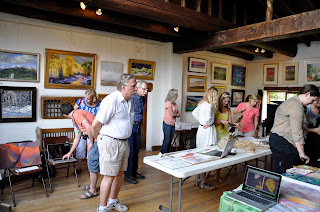During our Taos trip, we visited the Taos Pueblo. This Pueblo contains structures that are considered to be the oldest continuously inhabited communities in the USA. Spanish explorers invaded this community in 1540 believing that the Pueblo was one of the fabled golden cities of Cibola. The Pueblo people suffered other invasions from the Spanish throughout history. In 1847, the US Army destroyed the Pueblo's original church, and in 1906, the US Government took claim over 48,000 acres of mountain land including the sacred Blue Lake, a ritual site where Taos people go for ceremonial reasons. The land was returned to the Pueblo community in 1970, the only time in history that the American government actually returned land to indigenous people.
Throughout everything, the Taos Pueblo people have been able to maintain their strong cultural identity. Tiwa, their native language, is still spoken and passed down orally from generation to generation. The entire Pueblo village is walled off from the outside world separating the Taos people's old way of life from their new way of life.
I was fascinated by this community's ability to maintain their identity throughout the influx of invasions the Pueblo has faced throughout history. This inspired me to create a series based on the mending and "holding together" of this tribe's culture, even in today's modern world of change.
While in Santa Fe, we visited an amazing ceramics gallery and studio where I had the opportunity to purchase some micaceous clay. This is a type of clay that is native to the New Mexico region. Native Americans indigenous to this area traditionally use this type of clay to create pottery.
I absolutely loved this clay not only because it was beautiful, but it made my hands sparkle!
I began throwing a series of pots that I cracked and then wove together using embroidery thread, seed beads and goose feathers. I also made several clay beads of different shapes and sizes.
These pieces are not completely finished. I am planning to rethread them with handspun Navajo churro wool and handmade beads.
 |
| "Mend" |
 |
| "Exposed" view 1 |
 |
| "Exposed" view 2 |
 |
| "Restore" |
In Taos, I purchased some natural Navajo churro fleece. This type of wool was used by the Taos people to make clothing and other textiles. Upon a visit to the La Hacienda de los Martinez in Taos, we met a professional weaver that introduced me to the art of hand spinning with the use of a drop spindle. Unfortunately, once I arrived back home, I could not find one of these simple contraptions anywhere. So I made my own with a 3/8" dowel rod, a 4" round disk, and an eye hook. Spinning was really tricky at first, but by the time I was running out of wood to spin, I began to get the hang of it.


Spinning is a pretty simple process. After you spin the rovings into wool, you unwind your spindle of thread tightly over the back of a chair and tye the ends together. Then you use embroidery thread to tie the "hoop" of thread in place. Next, you slip your hoop of thread off of the chair and soak it in hot water. Finally, you hang your hoops of thread from hangers and weigh them down with chains, belts, whatever you can find to keep the thread from curling up. When the thread is dry, it is done!
I also decided to branch off from my "broken" series to create a series of dreamcatchers that represent the old traditions of the Pueblo people to the new traditions that have been placed upon them by outside influence of the Pan-Indian movement of the 70's.
The dreamcatcher was over 2' in diameter and would have been strung with handmade beads and feathers. Unfortunately, I formed the piece around a hemisphere of metal and it cracked into several pieces when it dried. I went ahead and fired the clay and attempted to epoxy the piece together, but it fell apart soon after this picture was taken.
The other dreamcatcher I created was based on my experience with the Earthship community outside of Taos near the Rio Grande Gorge. To me, these sustainable homes were the closest form of how today's people can live harmoniously with nature. The Earthships are composed mainly of mud and recycled glass, tires, etc. I felt it appropriate to create a dreamcatcher based upon these modern, recycled materials juxtaposed against the earth's natural clay that the Taos people used, as well as the Navajo churro wool.
First, I used acetone, string, and a lighter to cut the bottoms of various bottles. Then, I formed the shape of the dreamcatcher out of micaceous clay, based upon the composition of the glass bottles.
Next, I used a glass bottle cutter to cut the lip off of one of the bottles. This was VERY tricky and out of ruining several bottles, I only had one fully intact lip salvaged. Next, I smashed several bottles into my sink and gathered broken glass pieces that I liked. I smoothed the edges with sandpaper that was submerged in water.
Next, I purchased a diamond core drill bit and drilled holes through the pieces of glass to be able to hang them from the dreamcatcher.
I will have pictures of all of the finished projects soon in my next blog!


























































